THE LIVING TAO : TIMELESS WISDOM FOR THE MODERN WORLD
This is a podcast dedicated to exploring the profound, yet elusive True Tao (真道). Acknowledging that the essence of Tao is beyond traditional discourse and expression, this series seeks to demystify Taoist principles and adapt them for contemporary listeners. Each episode offers a blend of ancient wisdom and modern insights, providing practical guidance for navigating the complexities of today’s world. Whether you’re a seasoned practitioner or new to the path, join us in discovering how the timeless wisdom of Tao can be lived out in the here and now.
Episodes
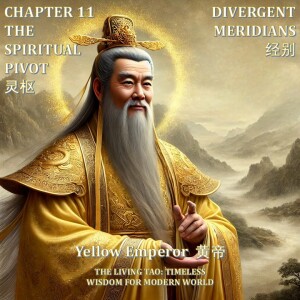
Tuesday Nov 26, 2024
Tuesday Nov 26, 2024
This Chapter from The Yellow Emperor’s Classic of Internal Medicine, specifically Chapter 11, "The Spiritual Pivot – Divergent Meridians." It details a dialogue between the Yellow Emperor and Qibo concerning the twelve primary meridians of Traditional Chinese Medicine and their diverging pathways. Qibo explains how these meridians branch out, connecting to various organs and body parts, creating a complex network crucial for vital energy (qi) and overall health. The passage meticulously charts these pathways, illustrating their points of divergence and convergence. The explanation emphasizes the interconnectedness of these meridians, showing how they form a unified system influencing both internal organs and external limbs.
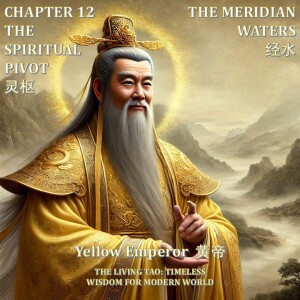
Tuesday Nov 26, 2024
Tuesday Nov 26, 2024
This Chapter is a dialogue from the Yellow Emperor's Classic of Internal Medicine, specifically Chapter 12, exploring the relationship between the twelve meridians and twelve bodies of water. Qibo, answering the Yellow Emperor's questions, explains the correspondence between the meridians, internal organs (zang and fu), and water systems, emphasizing the importance of balance and proper acupuncture techniques. He details specific needle depths and retention times for different meridians, based on their qi and blood characteristics and the patient's physique. Ultimately, the text advocates for a holistic approach to acupuncture, considering individual variation and adapting treatment accordingly.
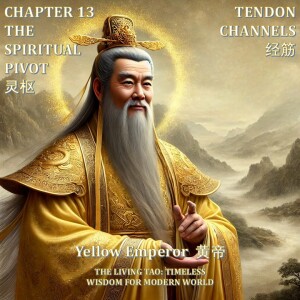
Tuesday Nov 26, 2024
Tuesday Nov 26, 2024
This Chapter from The Yellow Emperor’s Classic of Internal Medicine details the tendon channels (經筋) of traditional Chinese medicine. It meticulously describes the pathways of twelve channels, their associated symptoms of dysfunction (like pain, spasms, and stiffness), and treatments (primarily acupuncture and cauterization). Each channel's dysfunction is linked to a specific season, highlighting the influence of environmental factors on health. The text also discusses general principles governing tendon channel disorders, differentiating between cold- and heat-induced conditions. Finally, it emphasizes treatment based on the location and intensity of the symptoms.
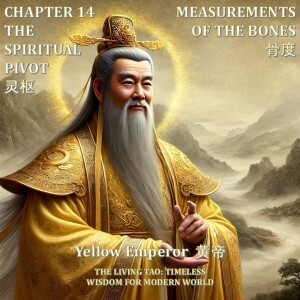
Tuesday Nov 26, 2024
Tuesday Nov 26, 2024
This Chapter from the Yellow Emperor's Classic of Internal Medicine, details precise bone and joint measurements of an average person (7 feet 5 inches tall) as a foundation for understanding meridian lengths in traditional Chinese medicine. The measurements, provided by Bo Gao in response to the Yellow Emperor's inquiries, cover the head, torso, limbs, and spine, with variations noted to indicate organ size discrepancies. These anatomical proportions serve as a basis for interpreting pulse characteristics, connecting physical dimensions to internal energy (qi) and blood levels. The text highlights the interdependence of physical structure and internal physiological states.
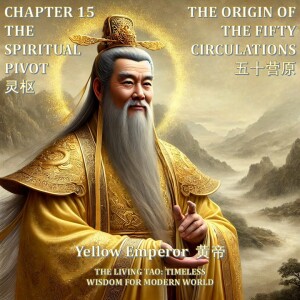
Tuesday Nov 26, 2024
Tuesday Nov 26, 2024
This Chapter from The Yellow Emperor’s Classic of Internal Medicine explains the concept of the "fifty circulations" (五十营, wǔshí yíng) of qi within the human body. It describes the daily cyclical movement of qi through 28 meridians, correlating this internal process to the celestial movements of the 28 constellations. The text details the precise calculations of qi's movement based on breath cycles and their relationship to time measurements using a water clock. Ultimately, the unobstructed completion of these fifty circulations is presented as essential for achieving a full lifespan. The text emphasizes the harmonious correspondence between the microcosm of the human body and the macrocosm of the heavens.
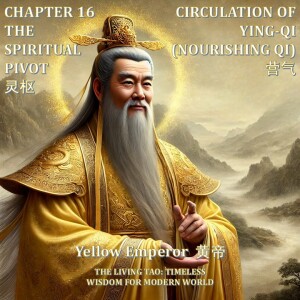
Tuesday Nov 26, 2024
Tuesday Nov 26, 2024
This Chapter from The Yellow Emperor's Classic of Internal Medicine details the pathway of ying qi (nourishing qi) through the body's meridian system. The text describes ying qi's origin in ingested grains, its circulation through various meridians, and its cyclical flow, emphasizing the continuous nourishment it provides. Specific meridian pathways are meticulously traced, highlighting the upward and downward movements of ying qi. Branch pathways are also noted, including connections to the Governing Vessel and reproductive organs. The overall description illustrates the vital role of ying qi in maintaining bodily balance and health.
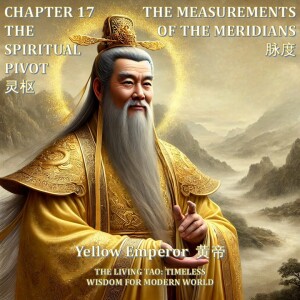
Tuesday Nov 26, 2024
Tuesday Nov 26, 2024
This Chapter from the Yellow Emperor's Classic of Internal Medicine, details the measurements of the body's meridian pathways within traditional Chinese medicine. It describes the lengths of various meridians, differentiating between yin and yang channels of the hands and feet, and the unique characteristics of the Qiao Mai (Heel Vessels), Du Mai (Governing Vessel), and Ren Mai (Conception Vessel). The text also explores the relationships between the five zang organs and the seven orifices, the consequences of imbalances between yin and yang, and the cyclical nature of qi flow within the meridians. Finally, it explains the flow of qi to the zang organs and the role of meridians in maintaining health and preventing disease.
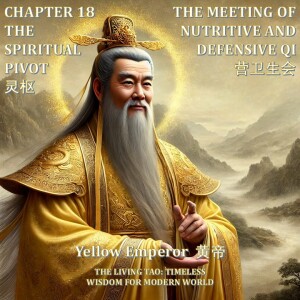
Tuesday Nov 26, 2024
Tuesday Nov 26, 2024
This Chapter is a dialogue from the Yellow Emperor's Classic of Internal Medicine, specifically Chapter 18, exploring the nature and functions of ying (nutritive) and wei (defensive) qi. The discussion details how these qi are formed from ingested food, their circulatory pathways, and their relationship to yin and yang. The text further contrasts the qi of the young and the elderly, explaining differences in sleep patterns and overall health. Finally, it clarifies the roles of the three jiao (upper, middle, and lower) in the transformation and distribution of qi and fluids within the body.
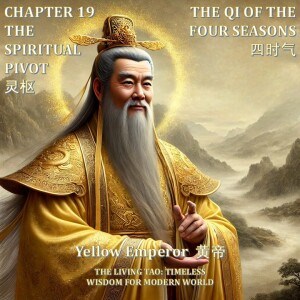
Tuesday Nov 26, 2024
Tuesday Nov 26, 2024
This Chapter from The Yellow Emperor’s Classic of Internal Medicine, specifically Chapter 19, detailing acupuncture and moxibustion techniques based on seasonal qi (energy) and meridian pathways. It outlines treatments for various ailments, including digestive issues, edema, and pain, emphasizing diagnostic methods such as pulse examination and observing the patient's physical presentation. The chapter offers specific acupoint selections and needling depths for each season, tailoring treatment to the body's seasonal energetic flow. Detailed treatment protocols are given for numerous conditions, with instruction on needling techniques and dietary restrictions.
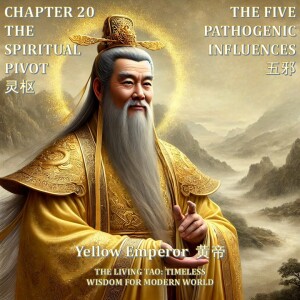
Tuesday Nov 26, 2024
Tuesday Nov 26, 2024
This Chapter from The Yellow Emperor's Classic of Internal Medicine details treatments for imbalances affecting the five vital organs—lungs, liver, spleen/stomach, kidneys, and heart—within the framework of Traditional Chinese Medicine. Each organ's ailment is characterized by specific symptoms, such as pain in the skin (lungs) or bones (kidneys), and treated using acupuncture at key meridian points like Stomach 36 and Kidney 1, alongside techniques such as bleeding or applying pressure. The text emphasizes individualized treatment based on the patient's unique symptoms and yin-yang balance. The author highlights the importance of harmonizing the body's internal and external dynamics to restore health.

The Living Tao
Welcome to The Living Tao: Timeless Wisdom for the Modern World—your guide to living a life of balance, wisdom, and inner peace. Inspired by the profound teachings of ancient masters, this podcast explores the enduring relevance of these timeless insights in today’s fast-paced world.
Taoist teachings emphasize living in harmony with the natural flow of life—the Tao, or "the Way." This philosophy invites us to embrace simplicity, cultivate humility, and find peace by aligning ourselves with the rhythms of the universe. At its heart, Taoism encourages us to let go of resistance, shed the distractions of ego, and discover the profound serenity that comes from living authentically and in tune with our true nature.
The Tao Te Ching, attributed to Laozi, is one of the most influential texts in Taoism and serves as a cornerstone of our discussions. Its poetic verses guide us to reflect on themes like balance, self-awareness, and effortless action, or wu wei. These teachings are not bound by time or culture—they resonate just as powerfully today, offering insights that help us navigate the complexities of modern life with grace and equanimity.
Each episode of The Living Tao will uncover practical wisdom rooted in these ancient teachings, presenting it in ways that are both accessible and transformative. Whether it's understanding the art of stillness in a world of constant movement, finding clarity amid chaos, or exploring the paradoxes of strength through softness, you’ll discover tools and perspectives to enrich your life and deepen your connection to the world around you.
Whether you're a seasoned practitioner familiar with the Taoist path or a newcomer drawn to its gentle yet profound philosophy, this podcast offers something for everyone. Together, we'll explore how these age-old principles can help us embrace change, cultivate mindfulness, and find a sense of purpose and inner peace in the face of life's challenges.
Join us on this journey of self-discovery, as we bring the wisdom of the Tao into the present moment. Let the timeless truths of this ancient tradition inspire and empower you to live a more harmonious and enlightened life. Tune in, reflect, and allow the teachings of The Living Tao to guide you back to the essence of who you are.








